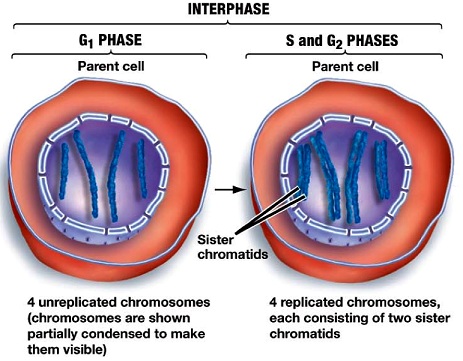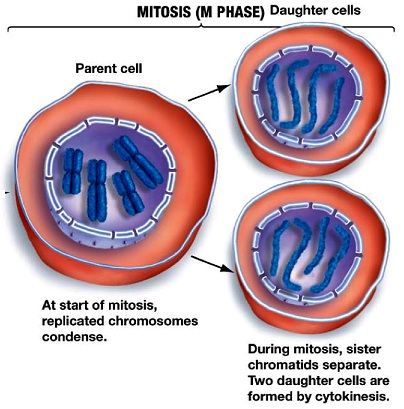Phases of Cell Cycle and Cell Division
Table of Content |
-
 Rudolf Virchow (1855,1859) was the first to suggest that new cells are formed from the division of the pre-existing cells- omnis cellula e cellula (every cell is derived from a cell).
Rudolf Virchow (1855,1859) was the first to suggest that new cells are formed from the division of the pre-existing cells- omnis cellula e cellula (every cell is derived from a cell). -
In 1873, strasburger similarly proposed that nuclei are formed from pre-existing ones. Boveri (1879) and Flemming (1879, 1880) studied details of somatic cell division.
-
It is the process by which a mature cell divides and forms two nearly equal daughter cells which resemble the parental cell in a number of characters.
-
"Continuity of life" is an important intrinsic characteristic of living organisms and is achieved through the process of reproduction. The reproduction may be asexual or sexual. Both of these involve the division and replication of cells. Even the growth and development of every living organism depends on the growth and multiplication of its cells.
-
In unicellular organisms, cell division is the means of reproduction by which the mother cell produces two or more new cells. In multicellular organism also, new individual develop from a single cell. The zygote, by the cell division. Cell division is central to life of all cells and is essential for the perpetuation of the species.
-
A cell divides when it has grown to a certain maximum size which disturb the karyoplasmic index (KI)/Nucleoplasmic ratio (NP)/Kernplasm connection. Two processes take place during cell reproduction.
(a) Cell growth : (Period of synthesis and duplication of various components of cell).
(b) Cell division : (Mature cell divides into two cells).
(3) Cell cycle : Howard and Pelc (1953) first time described it. The sequence of events which occur during cell growth and cell division are collectively called cell cycle. Cell cycle completes in two steps:
(i) Interphase
(ii) M-phase/Dividing phase
G1 Phase/Post Mitotic/Pre-DNA Synthetic Phase/Gap Ist
In which following events take place: 
(a) Intensive cellular synthesis.
(b) Synthesis of rRNA, mRNA ribosomes and proteins.
(c) Metabolic rate is high.
(d) Cells become differentiated.
(e) Synthesis of enzymes and ATP storage.
(f) Cell size increases.
(g) Decision for a division in a cell occurs.
(h) Substances of G stimulates the onset of next S – phase.
(i) Synthesis of NHC protein, carbohydrates, proteins, lipids.
(j) Longest and most variable phase.
(k) Synthesis of enzyme, amino acids, nucleotides etc. but there is no change in DNA amount.
S-phase/Synthetic Phase
(a) DNA replicates and its amount becomes double (2C - 4C).
(b) Synthesis of histone proteins.
(c) Euchromatin replicates earlier than heterochromatin.
(d) Synthesis of NHC (non-histone chromosomal proteins).
(e) Each chromosome has 2 chromatids.
G2-Phase/Pre Mitotic/Post Synthetic Phase/Gap-IInd
(a) Intensive cellular synthesis.
(b) Increase in energy store.
(c) Mitotic spindle protein (tubulin) synthesis begins.
(d) Chromosome condensation factor appears.
(e) Synthesis of 3 types of RNA and NHC proteins.
(f) Synthesis of ATP molecule and storage.
(g) Duplication of mitochondria, plastids and other cellular macromolecular complements.
M-Phase/Dividing Phase/Mitotic Phase
(a) M –phase is the final phase of cell cycle.
(b) It represents the phase of actual division.
(c) Prior to it, the cell components have undergone duplication.
(d) M – phase is, therefore, the stage of separation of already duplicated components.
(e) It consists of karyokinesis (division of nucleus) and cytokinesis (division of cell protoplast.).
G0 – Phase (Quiescent Stage)
(a) It is the stage of inactivation of cell cycle due to non-availability of mitogens and energy rich compounds.
(b) The cells remain metabolically active.
(c) They do not grow or differentiate.
(d) The cells function as reserve cells which can join cell any time.
|
Differences between G1 and G2 phases |
||
|
S.No. |
G1 phase |
G2 phase |
|
1. |
It is the first substage of interphase. |
It is the last substage of interphase. |
|
2. |
Available factors determine its fate, entry in G 0, differentiation or continuity of cell cycle. |
There is very little choice for the cell except to proceed further in cell cycle. |
|
3. |
Cell organelles do not increase in number. |
|
|
4. |
Cell grows in size but growth of nucleus is little. |
Both cell and nucleus grow in size. |
|
5. |
It synthesizes RNAs, proteins and other biochemicals for cell growth and subsequent replication of DNA. |
It synthesizes RNAs, proteins and other biochemicals for spindle formation and M- phase division. |
Differentiation Phase
(a) Most of the cells leave the G1-phase midway.
(b) They grow in size, assume particular shape and come to have a particular function. The phenomenon is called cell differentiation.
Duration of Cell Cycle
It depends on the type of cell and external factors such as temperature, food and oxygen. Time period for G1, S, G2 and M-phase is species specific under specific environmental conditions. e.g. 20 minutes for bacterial cell, 8-10 hours for epithelial cell, and onion root tip cells may take 20 hours.
Regulation of Cell Cycle
Stage of regulation of cell cycle is G1 phase during which a cell may follow one of the three options.
(i) It may start a new cycle, enter the S-phase and finally divide.
(ii) It may be arrested at a specific point of G1 phase.
(iii) It may stop division and enter G0 quiscent stage. But when conditions change, cell in G0 phase can resume the growth and reenter the G1 phase.
|
|


Q.1 Which one connected with the cell division [CMC Vellore 2002]
(a) ER (b) Peroxysomes
(c) Ribosomes (d) Microtubules
Q.2 Cell division is initiated by [CBSE PMT 1993]
(a) Centrosome (b) Centriole
(c) Centromere (d) Chromomere
Q.3 Cell division in blue-green algae is more or less similar to that in [MP PMT 1994]
(a) Red algae (b) Green algae
(c) Brown algae (d) Bacteria
Q.4 Which one of the following forms the spindle apparatus during cell division [Kerala CET (Med.) 2002]
(a) Chromosome (b) Centrosome
(c) Ribosome (d) Kinetosome
Q.5 The replication of nuclear DNA occurs in [Kashmir MEE 1995; CPMT 1996; MP PMT 1994]
(a) G1 phase (b) G2 phase
(c) S phase (d) M phase
Q.6 Duplication of chromosomes take place in [Bihar MDAT 1992; Pb. PMT 1999; CPMT 2001; MP PMT 2001]
(a) G1 phase (b) G2 phase
(c) S phase (d) In all of the above
Q.7 The number of DNA in chromosome at G2 stage of cell cycle [RPMT 2002]
(a) One (b) Two
(c) Four (d) Eight
Q.8 The decision for division occurs in a cell at [ST 1977]
(a) S phase (b) G2 phase
(c) G1 phase (d) None of these
Q.9 During interphase, RNA and proteins are synthesized in [MP PMT 1997]
(a) S phase (b) G1 phase
(c) G2 phase (d) In both G1 and G2 phases
Q.10 Mitosis results in [MP PAT 1995]
(a) Reduction in chromosome number
(b) Doubling of chromosome number
(c) Constant chromosome number
(d) Increase in cell volume


|
Q.1 |
Q.2 |
Q.3 |
Q.4 |
Q.5 |
|
d |
a |
d |
d |
|
|
Q.6 |
Q.7 |
Q.8 |
Q.9 |
Q.10 |
|
c |
b |
c |
d |
c |
Related Resources
-
Click here to refer the Useful Books of Biology for NEET (AIPMT)
-
Click here for study material on – Biomolecules
To read more, Buy study materials of Cell Cycle and Cell Division comprising study notes, revision notes, video lectures, previous year solved questions etc. Also browse for more study materials on Biology here.



